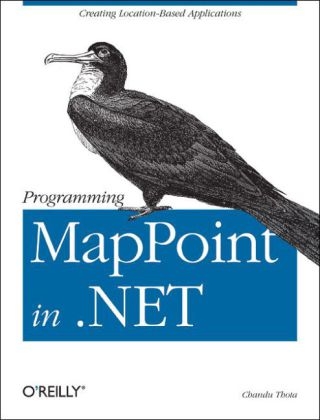
Programming MapPoint in .NET
O'Reilly Media (Verlag)
978-0-596-00906-9 (ISBN)
- Titel ist leider vergriffen;
keine Neuauflage - Artikel merken
Interactive web maps generated by MapPoint - Microsoft's popular mapping technology are crucial for businesses in a number of fields, including real estate, package delivery, and commercial air travel. In a word, MapPoint provides businesses with "location." Specifically, it provides an integrated set of products, servers, and services to enable a business to track the precise location of remote assets, thereby reducing operational costs and improving productivity. Whether the asset is a truck, a taxi, or even a field rep, MapPoint can tell you exactly where it is at any time. "Programming MapPoint in .NET" from O'Reilly shows you how to use MapPoint to build custom applications for the desktop, the web, and mobile devices. The book also explains how to analyze and share data generated from a wide range of maps, including those that show demographic trends, population density, and sales potential.
Chandu Thota, one of Microsoft's main MapPoint developers and the book's author, has organized the material into four major sections, each dedicated to a different MapPoint technology: MapPoint 2004 - calculating routes, rendering data maps, integrating with Global Positioning System (GPS) for obtaining real-time location; MapPoint Web Service - techniques for finding points of interest, creating applications using the Find APIs and Route APIs, rendering LineDrive maps and polygons; MapPoint Location Server - deployment scenarios, getting real-time location using mobile phones, managing contacts and privacy settings; MSN Virtual Earth - the basics of programming with new MSN Virtual Earth APIs. The book provides a jumpstart for working with these technologies, including in-depth discussions about the core concepts and sample code provided in C#. It's ideal for anyone who wants to develop locations-based applications with MapPoint technologies. The next time you follow online directions to the airport, you can chalk up an assist to MapPoint's state-of-the-art interactive mapping abilities. Better yet, you'll know how to create that same type of map yourself.
Chandu Thota works as a software design engineer for Microsoft Corporation in the MapPoint team. Having been a developer for more than 5 years, he wakes up everyday with a goal to make things as simple and efficient as possible for developers to build applications on the MapPoint platform. Chandu has published several articles related to the Microsoft .NET Framework and founded an online .NET Web Services portal, http://www.esynaps.com. He is also a co-author of the books Understanding the .NET Framework and Building an ASP.NET Intranet, both published by Apress.
Foreword Preface 1. Hello, MapPoint! Location-Based Application Categories Location Application Architectures Developing Location-Enabled Applications Developing Location-Aware Applications How It All Fits Together Where Are We? Part I. MapPoint 2004 2. Programming with MapPoint 2004 The MapPoint 2004 Object Model Programming with MapPoint 2004 API Programming the MapPoint ActiveX Control Cleaning Up After You're Done Dealing with Latitude and Longitude Routing in MapPoint 2004 Where Are We? 3. Working with Data in MapPoint 2004 Understanding the MapPoint 2004 Data API Understanding Data Maps Working with MapPoint Demographic Data Working with Your Business Data Querying a MapPoint DataSet Working with Shapes Working with Territories Where Are We? 4. Advanced MapPoint 2004 Programming Interfacing MapPoint 2004 with a GPS Device Integrating Your Applications with MapPoint 2004 Performance Considerations Where Are We? Part II. MapPoint Web Service 5. Programming MapPoint Web Service How Does MapPoint Web Service Work? Getting Started with MapPoint Web Service Preparing Your Development Environment Understanding MapPoint Web Service Object Model Where Are We? 6. MapPoint Web Service Find APIs Understanding Find APIs Understanding Entities and Entity Relationships Data Sources and Countries/Regions Working with Find Methods Asynchronous Programming with Find Service Optimizing Find Call Performance Globalizing Find Where Are We? 7. MapPoint Web Service Route APIs Understanding Route APIs Calculating a Route Displaying Details of a Route Where Are We? 8. MapPoint Web Service Render APIs Understanding Render APIs Rendering Maps Map Interaction Asynchronous Programming Where Are We? Part III. MapPoint Location Server 9. Programming Microsoft Location Server Microsoft Location Server Terminology How Does Location Server Work? Microsoft Location Server Architecture Installing the Location Server Accessing the Location Service APIs Accessing the Location Server APIs Microsoft Location Server Supported Providers Where Are We? 10. Programming with Location Server APIs Programming with Location Server Web Service Programming with the Location Server Management API Comparing Location Server API to Location Web Service API Where Are We? Part IV. MSN Virtual Earth 11. Programming with Virtual Earth Anatomy of Virtual Earth Programming with MapControl.js Where Are We?A. Managing Your Data on MapPoint's Customer Services Site B. Working with Polygons C. Implementing Spatial Search Using SQL Server Index
| Erscheint lt. Verlag | 17.1.2006 |
|---|---|
| Reihe/Serie | O'Reilly Ser. |
| Verlagsort | Sebastopol |
| Sprache | englisch |
| Einbandart | Paperback |
| Themenwelt | Informatik ► Office Programme ► Outlook |
| ISBN-10 | 0-596-00906-2 / 0596009062 |
| ISBN-13 | 978-0-596-00906-9 / 9780596009069 |
| Zustand | Neuware |
| Informationen gemäß Produktsicherheitsverordnung (GPSR) | |
| Haben Sie eine Frage zum Produkt? |
aus dem Bereich


